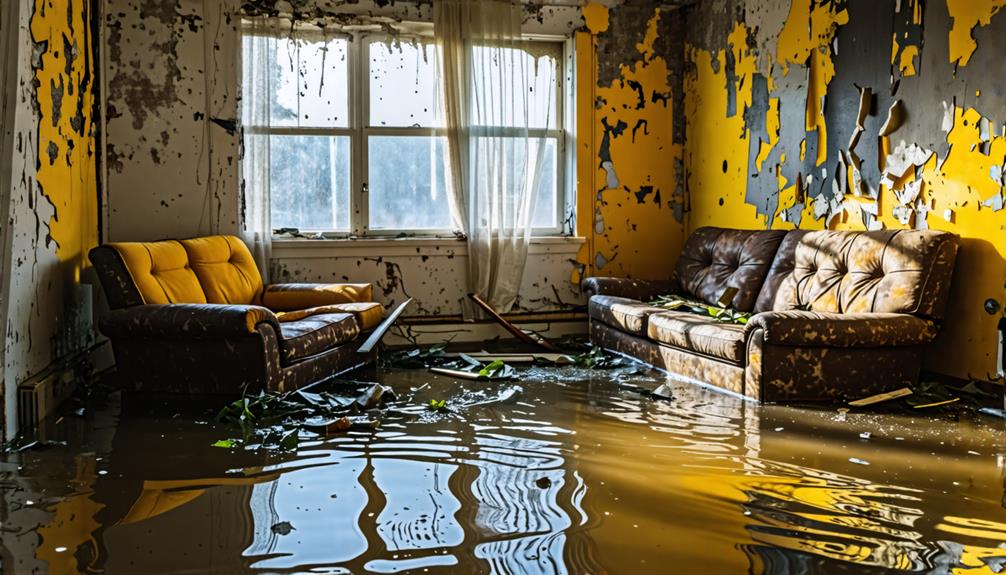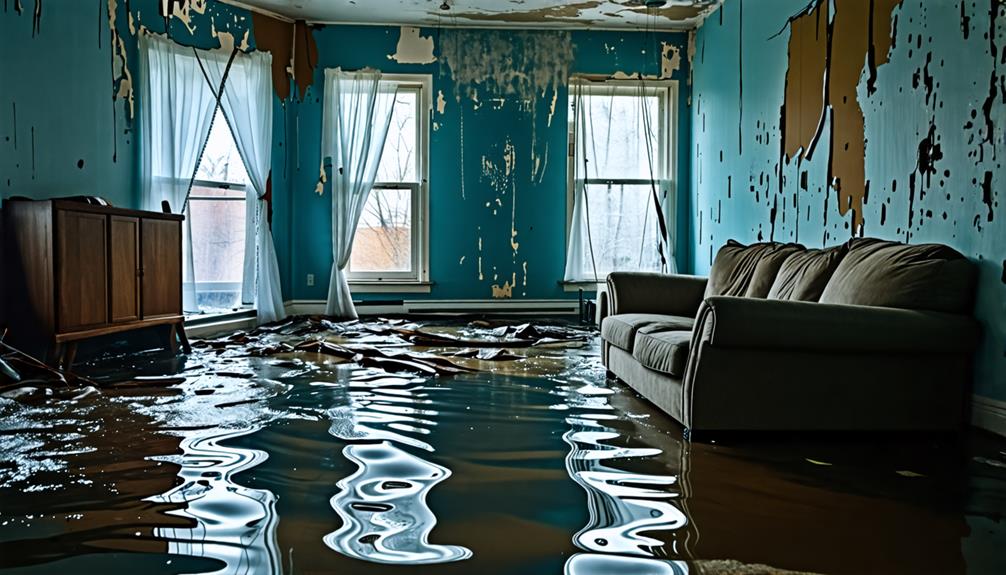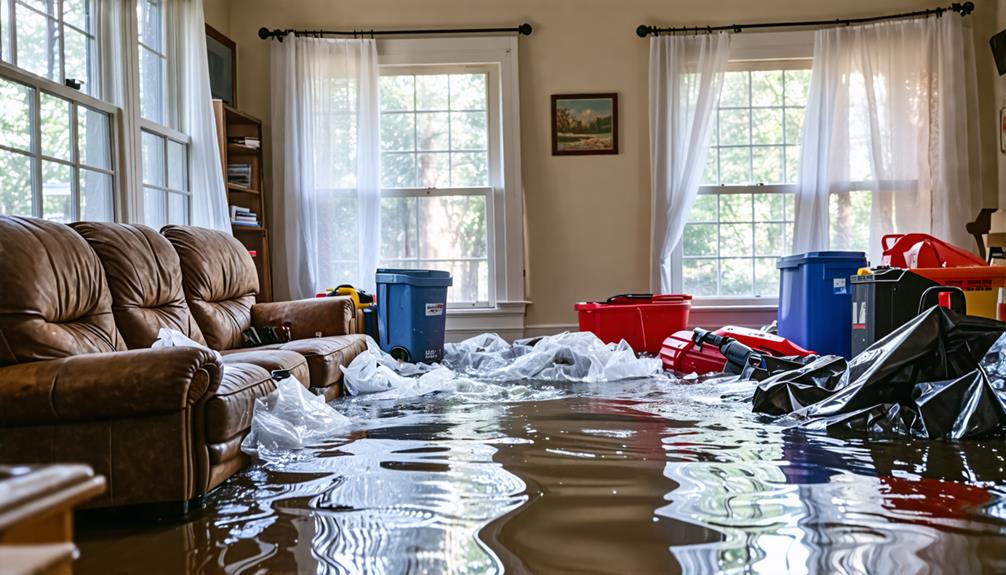Tropical Storm Debby's heavy rains can lead to severe water damage in your home, often hidden until it's too late. You might see subtle signs like stains on walls, a musty smell, or peeling paint. These indicate leaks that can compromise your home's structure and promote harmful mold growth. Mold thrives in damp conditions, posing significant health risks like respiratory issues and allergic reactions. Regular inspections and proactive measures can safeguard against these dangers. Staying alert to water damage signs and knowing when to call a professional will protect your home and health, leading to a safer living environment.
Key Takeaways
- Water damage from Tropical Storm Debby can lead to structural issues if leaks are not promptly addressed and repaired.
- Mold growth can occur within 24 to 48 hours of water exposure, posing serious health risks.
- Signs of water damage include stains, musty odors, and peeling paint, indicating potential hidden issues.
- Maintaining low indoor humidity and performing regular inspections can help prevent water damage and mold growth.
Understanding Water Damage

Water damage can sneak up on you, often starting with seemingly minor leaks that can lead to significant structural issues if left unchecked. Understanding the various water sources in your home is vital for protecting your sanctuary. These sources range from plumbing failures and appliance malfunctions to natural occurrences like heavy rain or flooding. It's easy to overlook a small drip or a damp spot, but these can be warning signs that indicate deeper problems.
You might think your insurance coverage will protect you from the fallout of water damage, but not all policies are created equal. Some may exclude specific types of water damage, such as flooding from natural disasters, while others might have limits on payouts for repairs. It's important to review your policy carefully and confirm you're adequately covered.
Taking proactive measures, like regular inspections and maintenance, can save you from costly repairs and emotional stress down the line. By staying informed about potential water sources and understanding your insurance coverage, you're better equipped to prevent and address water damage before it spirals out of control. Your home deserves that attention and care.
Common Signs of Water Damage
Noticing the early signs of water damage can save you from extensive repairs and financial strain later on. Being proactive is key, so keep an eye out for these common indicators:
- Visible stains on walls or ceilings
- Musty odors that linger in the air
When you spot visible stains, it often means water has infiltrated your home, signaling a leak that needs immediate attention. Don't ignore those musty odors, either; they're a telltale sign of mold or mildew growth, which can pose health risks.
Also, check for peeling or bubbling paint, as these are red flags indicating moisture trapped underneath the surface.
Long-Term Effects on Your Home

When water damage occurs, it can lead to serious long-term effects that threaten your home's structural integrity. You might not notice the subtle weakening of beams or walls until it's too late, and mold can silently flourish in damp conditions, posing health risks. Understanding these potential issues is essential for maintaining a safe and sound living environment.
Structural Integrity Concerns
Lingering moisture from water damage can silently undermine your home's structural integrity, leading to costly repairs and safety hazards over time. You might not even notice the damage until it's too late, but ignoring the signs can result in significant foundation issues.
Here are some critical concerns to keep in mind:
- Compromised Beams and Joists: Excess moisture can weaken the wood, leading to structural failures.
- Cracked Foundation: Water can erode the soil around your home, resulting in cracks that compromise stability.
If you've experienced water damage, it's essential to assess your home's condition promptly. Early detection can save you from extensive structural repairs down the line. Ignoring these issues can lead to more than just cosmetic problems; it can jeopardize the very foundation that supports your entire home. Don't wait until it's too late—take action now to protect your sanctuary. You deserve a safe and sound living environment, free from hidden dangers lurking beneath the surface.
Mold Growth Risks
Ignoring the structural damage from water can lead to another hidden threat: mold growth, which thrives in damp environments and poses serious long-term risks to your home's health and safety. Once water infiltrates your space, mold initiates its lifecycle, rapidly spreading in just 24 to 48 hours. This isn't just about unsightly patches; mold can trigger respiratory issues, allergies, and other health problems for you and your loved ones.
Controlling humidity is vital to preventing mold. Ideally, you want to keep indoor humidity levels below 60%. Use dehumidifiers, fans, and proper ventilation to create an environment where mold struggles to survive. If you notice musty odors or discolored areas, it's time to act.
Addressing water damage thoroughly can save you from costly repairs down the road. Don't underestimate mold's potential to compromise not only your home's integrity but also your family's well-being. By staying vigilant and proactive, you can safeguard your home against mold and its hidden dangers. Your home deserves this care, and so do you.
Mold Growth and Health Risks
When water damage occurs, mold can quickly become a hidden menace in your home. Different mold types can lead to a range of health issues, so it's essential to recognize the symptoms and understand how to prevent and remediate this problem effectively. Let's investigate how you can safeguard your health and your home from the risks associated with mold growth.
Mold Types and Effects
Mold can thrive in damp environments, posing significant health risks that you might not even be aware of. Understanding the various mold varieties in your home is vital for your health and safety. Here are some common types you should know:
- Aspergillus: Often found in damp spaces, it can trigger respiratory issues.
- Stachybotrys (Black Mold): This toxic mold is notorious for causing severe allergic reactions.
These molds don't just look unsightly; they can infiltrate your airways and lead to chronic health issues. If you're experiencing unexplained headaches, fatigue, or respiratory problems, mold might be the hidden culprit. Mold prevention is fundamental—keeping humidity levels low and ensuring proper ventilation can help you avoid these risks.
Stay vigilant after a storm or water damage; the sooner you address any moisture issues, the better your chances are of preventing mold growth. Remember, your home should be a sanctuary, not a breeding ground for harmful microorganisms. Prioritize your health by understanding the dangers lurking in damp corners.
Prevention and Remediation Strategies
To effectively prevent and remediate mold growth in your home, you must understand the critical steps that can protect your health and living environment. First, invest in waterproofing techniques for your basement and foundation. This includes sealing cracks and applying waterproof coatings that block moisture intrusion. By doing so, you create a barrier against mold-friendly conditions.
Next, focus on drainage solutions. Confirm that gutters and downspouts direct water away from your home's foundation. Consider installing French drains or surface drains to manage groundwater effectively. Proper drainage keeps excess moisture at bay, greatly reducing mold risk.
Additionally, maintain indoor humidity levels below 60%. Use dehumidifiers in damp areas, and verify proper ventilation in bathrooms and kitchens. Regularly inspect your home for leaks and promptly repair any water damage.
Health Symptoms to Watch
Recognizing the health symptoms associated with mold growth is important, especially after implementing prevention and remediation strategies in your home. Mold thrives in damp environments, and if you've experienced water damage, it's critical to stay vigilant. Here are some symptoms to watch for:
- Allergic reactions: Sneezing, runny nose, and itchy eyes can indicate mold exposure.
- Respiratory issues: Coughing, wheezing, or shortness of breath may arise, especially in sensitive individuals.
Ignoring these signs can lead to serious health risks, including waterborne illnesses, and worsen existing conditions like asthma. If you notice any of these symptoms, it's important to address the mold issue promptly. You don't want to compromise your health or that of your loved ones.
Prevention and Mitigation Strategies

Implementing effective prevention and mitigation strategies can protect your home against the hidden dangers of water damage. Start by investing in waterproofing techniques, such as sealing your foundation and applying waterproof membranes. These steps create a barrier that minimizes moisture intrusion, helping you maintain a dry environment.
Next, focus on drainage solutions. Verify your gutters and downspouts direct water away from your home's foundation. Installing a French drain or a sump pump can further protect against flooding during heavy rains. Regularly inspect these systems for clogs or damage to keep them functioning efficiently.
Inside your home, monitor areas prone to leaks, like under sinks and around appliances. Using absorbent mats can help catch any unexpected spills or leaks before they escalate. Furthermore, maintain an eye on humidity levels; using a dehumidifier can greatly reduce moisture in the air, preventing mold growth.
When to Call a Professional
Even with the best prevention strategies in place, there are times when water damage becomes too overwhelming to handle on your own, making it important to know when to call a professional for help. Recognizing the signs early can save you from more extensive damage and costly repairs. Here are three significant indicators that it's time to seek a professional:
- Extensive Water Accumulation: If water is pooling in your home and you can't manage it quickly, don't hesitate to call for emergency response.
- Visible Mold Growth: If you spot mold, it's vital to get a professional assessment. Mold can spread rapidly and poses health risks to you and your family.
Don't underestimate the importance of expert help. A professional won't just clean up; they'll assess the situation thoroughly, ensuring that hidden problems are addressed. Trust your instincts—when in doubt, it's always better to err on the side of caution and call in a professional to protect your home.
Conclusion
In the wake of Tropical Storm Debby's deluge, don't underestimate the hidden dangers of water damage in your home. Ignoring the signs can lead to catastrophic consequences, from structural issues to health risks. Act now—check for leaks and mold before they spiral into a disaster that'll feel like a hurricane tearing through your living room. By staying vigilant and taking preventive steps, you can protect your sanctuary and guarantee your home remains a safe haven for years to come.
